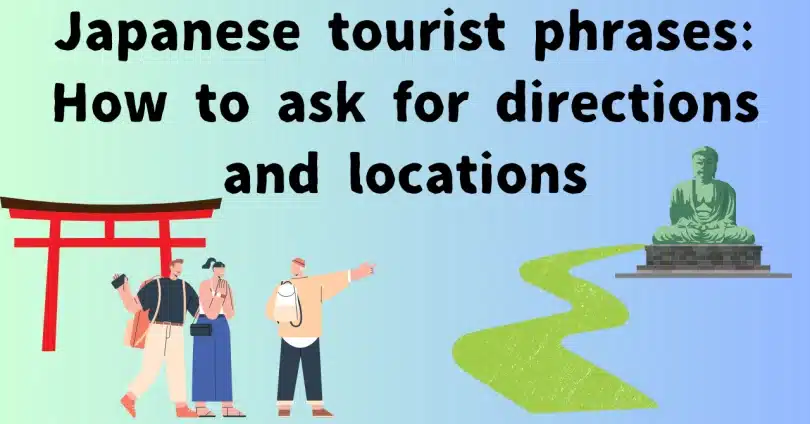Planning a trip to Japan? One of the most rewarding aspects of travel is immersing yourself in the local culture, and part of that involves mastering some essential Japanese tourist phrases. While English is spoken in many tourist areas, knowing a few basic Japanese phrases can greatly enhance your experience and increase your confidence during your travels. In this guide, we’ll focus on how to ask for directions and locations, covering important phrases for beginners, including how to ask for the bathroom, station, platform, and even a recommended restaurant.
Table of contents
Navigating Japan: Essential Japanese Tourist Phrases
すみません。 (Sumimasen)
– Excuse me
This is a versatile phrase that can be used in various situations. When asking for directions, it’s polite to start with “Sumimasen” to get someone’s attention before proceeding with your request.
ここに いきたいです。(Koko ni ikitaidesu)
I wan to go to this place.
In these days, many people probably use map applications such as Google. However, in places like Tokyo, where there are many buildings, it can be a challenge to find the right place. In such cases, point to the map and say this phrase.
“koko” means “here/this place”. So please use with pointing the map.
{えき} は どこですか? ({Eki} wa doko desu ka? )
– Where is {the station}?
If you’re in a bustling city like Tokyo or Osaka, you’ll likely find yourself in need of public transportation. “Eki wa doko desu ka?” is the perfect question to ask when you’re searching for the nearest train station.
“doko” means “where”. so, please introduce the place name to { }.
- Toire(トイレ) : Bathroom
- ATM
- Konbini(コンビニ) : Convenience store
- Takushii noriba (タクシーのりば) : Cab Stand
- Basu tei (バス停) : Bus stop
ありがとうございます。 (Arigatou gozaimasu)
Thank you.
Thank those who taught you well and say goodbye.

Do Japanese people speak English?
Japan probably has fewer English speakers than the rest of Europe. Many people are a little fearful of English. They run away from English, saying ”it is impossible”.
So, if you start with Japanese, even if it’s just one word, that person will be happy to help you. I often hear my students say that when Japanese people are asked for directions, they cannot explain well, so they say, “Follow me!(tuite kite)” and they will lead you to the place.
May you have a good luck in your travels!
If you are worried about your Japanese language skills, please use this Virttual assistant service from Linkup Nippon Agency.
We will support your trip.
Elicit information: Essential Japanese Tourist Phrases
Here are some phrases to make it easier to ask locals for local information and communicate with them.
おいしい おすしや を しりませんか? ({Oishii osushi ya} o shirimasenka)
Do you know a good sushi restaurant?
Planning a trip is great, but how about going to a restaurant recommended by a local?
“Shirimasenka” means “Do you know~?”. So, please put the place name or the thing to { }. And “Oishii” means “delicious”. Everybody travel to enjoy Japanese food, right?
- Oishii ramen ya (おいしい ラーメンや) : Delicious Ramen Restaurant
- Oishii izakaya(おいしい いざかや) : Delicious Japanese style-pub
- Yasukute oishii mise (やすくて おいしいみせ) : Inexpensive and delicious restaurant
ちかくに おもしろいところ は ありますか? (Chikakuni {omoshiroi tokoro} wa arimasuka?)
Are there any interesting place closed to here?
“Arimasuka” means “Are there”, so please put the place or thing with your wish to { }.
- Yuniiku na kafe(ユニークな カフェ) : Unique cafe
- kirei na otera (きれいな おてら) : beautiful temple
- Okonomiyaki ya (おこのみやきや) : Okonomiyaki shop
- Draggu stoa(ドラッグストア) : pharmacy
Let’s be honest, we are foodies and always looking for new experiences, no? You never know what unexpected and unique experiences await you in Japan.
Boost Your Confidence and Enjoy Japanese Travel
Mastering these Japanese tourist phrases is not only practical but also a great way to show respect for the local culture. Japanese people are generally very patient and appreciative when foreigners make an effort to speak their language.
Remember, learning a new language takes time, and you might make mistakes along the way. Don’t be discouraged by slip-ups; they are a natural part of the learning process. With each interaction, you’ll gain confidence, and your travels in Japan will become even more enriching.
So, pack your bags, prepare your phrases, and get ready for an unforgettable adventure in Japan. With a little language skill under your belt, you’ll navigate this beautiful country with ease and immerse yourself fully in its rich culture and traditions. Sayōnara (さようなら) and have a fantastic trip!
Check this article! : How to ask destination in Japanese.
READY TO TRAVEL? CHECK Travel Items for Japan!
TESSAN US to Japan Plug Adapter
The voltage in Japan is 100 volts (95 volts in some regions) at a frequency of 50 Hertz, while in the United States, it’s typically 120 volts (or 110 volts in certain areas) at a frequency of 60 Hertz. Due to these voltage and frequency differences, it’s essential to exercise caution when using electronic devices or appliances. Always check the specifications of your devices and, if necessary, use voltage converters or adapters to ensure compatibility.
Click to go to the Amazon product page.
The journey to Japan is a long one.It is also convenient for airplanes and travel within Japan by shinkansen.
Click to go to the Amazon product page.
Tide Liquid Travel Sink Packets, 3-Count
 Click to go to the Amazon product page.
Click to go to the Amazon product page.
The journey to Japan is a long one.It is also convenient for airplanes and travel within Japan by shinkansen.










